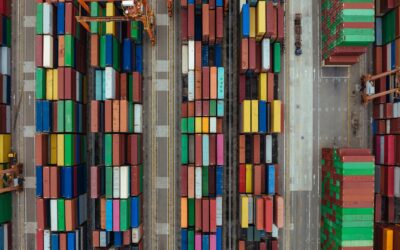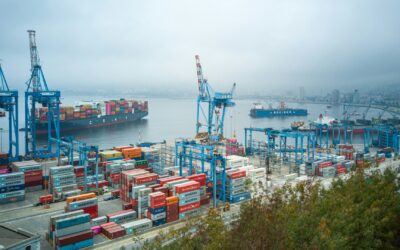According to the Biden administration’s recent National Security Strategy report, China “presents America’s most consequential geopolitical challenge.” Perhaps so. Beijing’s territorial ambitions in the East and South China Seas (including its designs on Taiwan and its semiconductor industry), is stirring up cold war anxieties between the world’s superpowers. On top of growing nationalism and the breathtaking wave of trade sanctions, these uncertainties have shaken the foundations of globalization and the aspirations of free and open trade. However, one thing for certain is that global supply chains are being transformed in the name of economic and national security. A major concern is the extraordinary amount of shipping passing through the South China Sea alone, estimated to be $5.3 USD trillion annually. This equals more than 60% of global maritime trade and 22% of total global trade. Any sort of disruption, including a military miscalculation or blockade, would have disastrous results for the world economy.
Compounding this worrisome mix of hypotheticals is Russia’s war in Ukraine, the energy crisis, the shift towards renewables, and the transition from internal combustion engines to electric vehicles. The latter will necessitate critical minerals and rare earth materials from nations hostile to U.S. foreign policy objectives. Another worry is the potential for new variants of Covid-19 and other future pandemics. Consequently, many nations are remolding their supply chain strategies to include friend shoring, nearshoring, reshoring, or other euphemisms describing the reversal of more than three decades of integrating far-flung supply chains around the world. Major trading nations today are looking for ways to reduce their dependencies to counter economic, political, and military coercion by countries ideologically opposed to the neoliberal economic order on one hand, and autocracy on the other. Resiliency in production and distribution has now eclipsed cheap labor, efficiency, productivity, and interdependency.
Even before Covid-19, there were signs that globalization was trending towards slowbalisation. The security-first model of manufacturing that has since gained traction will likely reduce global output in the short and medium terms while raising costs to manufacturers and consumers alike. This is one of the many trade-offs of agility and resiliency. For example, industrial policies and government subsidies that engender onshoring— including the $52 billion Chips and Science Act recently passed by U.S. Congress along with the counterintuitive Inflation Reduction Act — will impose immense costs on taxpayers while diminishing our nation’s market-driven competitiveness. This is not to suggest that state planning should not have a role in the economy so long as it does not become politically motivated to the benefit of favored groups or lose focus of its stated intent(i.e., supporting national competitiveness, skill building, and creating supply chains resistant to external shocks).
How did we arrive to the point where the ostensible peace dividend gained from aligning economic interests through global trade came to an abrupt halt? Credit the infamous Thucydides‘ Trap, whereby one great power seeks to displace the reigning incumbent. As the West slept walked, China became a chess grandmaster in gaming their mercantilist system once it ascended into the World Trade Organization (WTO) in 2001. In retrospect, it was a strategic blunder by Western policymakers lacking cursory knowledge of Chinese history and philosophy. Conversely, it was a Machiavellian masterstroke in economic statecraft and intrepid manipulation by Beijing. Rather than nudging the Middle Kingdom to become a ‘normal nation,’ the WTO unwittingly gave them license to plunder intellectual property and engage in other unfair trade practices that tilted the board in China’s favor. Knowing that capitalistic countries would be unable to resist huge profits in a market of more than one billion people at the time, China elected to ignore the rules and conventions governing international trade and foreign direct investment. In exchange for market access, Beijing insisted on massive transfers of first-generation technologies from Western firms. This obviated the need to spend massive amounts of yuan required to organically research and develop scientific discoveries.
Recently imposed controls on U.S. semiconductor exports to China may have been too little, too late considering their widely used commercial and military applications already been exploited by Beijing. Their ill-gotten technological gains along with the savings realized from poaching other nation’s IP has been channeled to state-owned enterprises that eventually competed directly with their Western counterparts for global market share in many strategic industries. The IP was also used for a massive defense buildup. So much for hiding their strengths and biding time, the guiding philosophy of paramount leader Deng Xiaoping (channeling his inner Sun Tzu in “The Art of War”)who was bent on challenging Western supremacy when he began modernizing China in 1979. Today, the Peoples Liberation Army and its blue water navy pose significant risks to many nations in the Indo-Pacific and Oceanic regions—including freedom of passage and shipping in international waters.
In addition to leapfrogging the West in many key industries such as artificial intelligence and 5G, China’s opportunistic strategy provided them with the tools required to export their economic, political, and social agendas aroundthe world. The Belt and Road Initiative (BRI) is a case in point. The BRI brought countries into China’s orbit with the promise of major infrastructural spending on airports, rail, roads, seaports, and mining and energy concessions in Africa, Asia, and Latin America’s lithium triangle. Hardly benevolent and unconcerned with improving living standards, global elites of recipient countries lined their pockets and squirreled away enormous funds into their personal bank accounts overseas. China’s lending also resulted in debt-trap diplomacy, undermining the national sovereignty of nations unable to repay their loans to China. Sri Lanka, who defaulted on its largesse from China and declared bankruptcy, is on the hook for a ninety-nine-year lease of its Chinese-built, deep seaport. If this appears eerily similar to how the British Empire imposed its will on China in1898 to secure its ninety-nine-year lease on Hong Kong, it is because it is from the same imperialist playbook.
Transplanting well-oiled supply chains that are inextricably intertwined is no easy feat—-especially if you happen to manufacture and sell in a rogue country like China. After more than thirty years of developing and cultivating a reliable supplier base, starting over is analogous to removing gum from hair. Trillions of dollars of capital expenditures (plants, warehousing, and distribution networks), trained labor, and the layered tiers of numerous suppliers cannot be magically teleported overnight to friendlier shores. However intuitive, do not overlook that supply chains encompass not just the production side but also distribution channels to reach buyers and end users. Therefore, any cost-benefit analysis for transplanting established base of suppliers must factor into their calculations lost efficiency and productivity, demographics, higher labor costs, hiring and training new workers, identifying new suppliers, procuring locally sourced and more expensive materials, vertical integration, and rising consumer prices.
In search of a silver lining, onshoring production theoretically brings companies closer to their suppliers, buyers, and end users— thereby saving on energy transportation costs and improving their sustainability index. Economic history shows that wherever manufacturing goes, innovation soon follows—despite the wonders of digitalization, virtual reality, and Zoom meetings. More creativity happens when designers, engineers, and production workers are in close proximity to each other where lasting professional and personal relationships are formed. It is much easier to collaborate and informally bounce off innovative ideas when people share a common work area and time zone. Bringing production home has spillover effects on other industrial sectors of the local economy, creating an ecosystem of multidisciplinary knowledge workers who share their cross-industry expertise with other sectors of the economy.
When Industry 4.0 (a.k.a., smart factory, the Industrial Internet of Things, and the Fourth Industrial Revolution) was coined as a term by Germany in 2011, it aimed at bridging the gap between the physical and digital worlds of design, engineering, and manufacturing but was then limited to certain industries. Eleven years later, it is hard to point to any company that has not embraced some facet of the underlying technologies and processes supporting Industry 4.0. It is ubiquitous and omnipresent, especially when discerning where the hardware of a product ends and embedded software begins. Indeed, the software-first approach to manufacturing feeds into the security-first approach to reimagining supply chains. In addition, the trend from just-in-time delivery to a just-in-case approach to buffering supplier inventory is back in vogue, according to Glenn Gerhard, president and CEO of Chrysan Industries, a Michigan-based automotive supplier.
To a certain degree, digitalization and the exponential growth of technology will cushion the U.S.-Sino split and decoupling of trade. As we have seen, a software first approach to innovation and manufacturing (aided by automation and robotics, 3-Dprinting, artificial intelligence, machine learning, and the Internet of Things)reduces the need to build physical plants overseas in what later can become volatile countries. Western economies are, first and foremost, knowledge-based entities and free enterprises adept at countering world economic challenges. Despite losing jobs to cheap labor overseas since 1990, manufacturing output has remained the same in the U.S. since 1990 thanks to technology’s knack for increasing productivity. It takes brains and less brawn to achieve the sophistication of today’s smart factories that can mitigate logistical bottlenecks, an aging demography, and labor and talent shortages. Strategies dealing and even profiting from fragile supply chains involve adopting and implementing technology designed to take the edge off of China’s wolf warrior approach to its foreign policy. According to Christopher Mims of the Wall Street Journal, “who wins and who loses in supply chains will depend on who is able to make use of automation and software to pare down industry’s dependence on workers and make those who remain that much more productive.” This, and this alone, is key to offsetting the stress of globalization going into reverse and overcoming the challenges outlined in the National Security Strategy Report.
Noel Nevshehir is director of Automation Alley’s International Business Services and Global Strategic Partnerships. In this role, Nevshehir is responsible for leading Automation Alley’s trade mission program and foreign direct investment efforts. He is also responsible for seeking out global strategic partners that align with Automation Alley’s Industry 4.0 mission.




